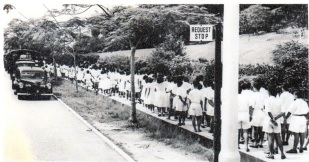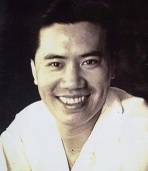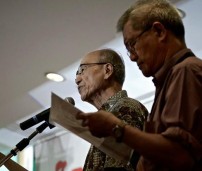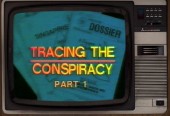Below is the speech of Dr Poh Soo Kai delivered at the lunch commemorating the 60th Anniversary of the May 13, 1954 Incident and the arrests of all the members of Editorial Board Fajar, a student publication of the University Socialist Club of Malaya. Dr. Poh Soo Kai was President of the club and Chairman of the Editorial Board. The students were charged for sedition.
“Comrades & friends,
Selamat petang! Zhong wu hao! Good-day! Firstly, let me take this opportunity to thank MARUAH and F8 for organizing this gathering today – 60 years after the historical event on May 13th 1954. (See photos)
May 13th 1954 marked an important watershed in reviving the people of Singapore’s struggle towards independence. We have to keep in mind that in 1954 Singapore was still a colony and the post Second World War’s cries for independence in the island as in the Malayan peninsula had been muted by the brute force unleashed by the British declaration of Emergency in 1948. The Batang Kali massacre, being litigated today, is one such grim reminder of those dark days. However, the May 13th 1954 student movement was to change all that for Singapore and lift the people’s struggle for independence from Britain.
A month before, in April 1954, the British colonial government had introduced national service conscription for male youth of Singapore. In its commentary on it, the University Socialist Club wrote in its May 10th Fajar issue that we did not understand the meaning of the word, “national” since we were a colony; the British did not deem us fit to rule over ourselves, yet we were deemed fit to fight and die for them!
Most affected by this new regulation, since they were the majority of the youths, were the Chinese middle schools students, who logically decided to petition the British Governor in Singapore for exemption from national service. On this fateful day of May 13th 1954, eight student representatives were to hand over the petition. Many other students turned out en masse to support their representatives and lined the pavement from River Valley Road /Clemenceau Avenue to Government House. The peaceable nature of the student assembly is borne out by postings on YouTube – an alternative media. However, they were set upon by baton wielding police of colonial Britain.
As a result, the students were beaten up and chased from Clemenceau Avenue to Stamford Road. They got a baptism in police brutality. Forty eight students were arrested on charges of obstructing police officers. Eventually, seven were found guilty and sentenced to three months’ rigorous imprisonment.
 These young innocent Chinese middle schools students had been dealt a bitter lesson that politicized them. They saw clearly who the dogs were and became keenly aware of themselves as the underdogs with no rights at all; no human rights that colonial Britain needed to
These young innocent Chinese middle schools students had been dealt a bitter lesson that politicized them. They saw clearly who the dogs were and became keenly aware of themselves as the underdogs with no rights at all; no human rights that colonial Britain needed to  respect or even pretend to respect. Alas! The only way forward for the students was to unite and unite ever more firmly with all other underdogs in Singapore society to pursue justice.
respect or even pretend to respect. Alas! The only way forward for the students was to unite and unite ever more firmly with all other underdogs in Singapore society to pursue justice.
The momentous year of 1954 also saw on May 28th, the arrest for sedition of the Fajar editorial team for its May 10th issue. Sedition was a very serious charge to level on these youths for patriotism and editorial independence. One of the recorded reasons for the arrest was that the police had found copies of Fajar among the belongings of the Chinese middle schools students and falsely assumed that, we, the Fajar boys were behind the Chinese middle schools students’ May 13th protest. Indeed, we Fajar boys and the University Socialist Club had given full support to the Chinese middle schools students. We also turned up as members of the Pan-Malayan Students’ Federation to demonstrate our solidarity when they occupied the Chinese High School. The unity of the English and Chinese educated students was forged at these moments when the mighty force of colonial Britain rained down unreasonably upon them.
D.N. Pritt Q.C. had defended us in the Fajar trial leading to our acquittal. This Queen’s Counsel had a reputation for strident anti-colonialism, battling imperialist Britain on behalf of her colonies. The Chinese middle schools students decided to approach Harry Lee Kuan Yew, who had been junior counsel in the Fajar case, to engage Pritt for their appeal. As expected, they lost their case. But that was how Harry Lee came to gain a foothold among the Chinese middle schools students
The Chinese middle schools students’ demand for respect of their human rights had set the example. Workers were encouraged. They too wanted their labour right to organize their own unions. This is a fundamental human right. Article 8 of the United Nations’ Convention on Economic, Social and Cultural Rights recognizes the right of workers to form or join trade unions and protects the right to strike.
On November 1, 1954, Jamit Singh had joined the Singapore Harbour Board Staff Association as a paid secretary. Jamit had hailed from the University Socialist Club. On May 1, 1955, Jamit led the Harbour Board staff association – the white collar workers – on a 67 days strike which culminated in victory. Jamit became a hero! He had stood firm in demanding just wages for union members, and brought the strike to public attention with pickets deployed at the gates of the harbour and outside key government institutions. Inspired by their white collar counterparts, the Habour Board’s blue collar workers demanded to join Jamit’s union; they did not want to be represented by unions set up and controlled by management. Jamit went on to strengthen workers’ unity by amalgamating the various small waterfront unions into a giant union of 10,000 members – the Singapore Harbour Board Workers’ Union.
Here I want to pay tribute to this comrade: Jamit Singh fought for what was fair and what was right and paid a very heavy price for his conviction and courage. Jamit, your struggle was not in vain; your fine example will continue to inspire us.
The workers’ struggles for their human and labour rights were naturally viewed with sympathy by the Chinese middle schools students who had been through the baptism of bruised and broken bodies on May 13th. They knew what it was like to be the underdogs fighting for their human rights to be respected. Hence, the Harbour Board white and blue collar workers and Jamit Singh received expression of solidarity from the Chinese middle schools students. A good number of students turned up at the picket lines to offer sympathy and support.
Around the beginning of 1955, the majority of the workers in Hock Lee Bus Company decided to form a branch of the Singapore Bus Workers Union that was led by Fong Swee Suan, Chen Say Jame and Lim Teow Peng. They did not want to be represented by the yellow union set up by management. However, management refused to recognize the genuine workers’ union and would only deal with its own workers’ union. An industrial dispute ensured. It was momentarily settled when the two unions agreed to arbitration presided over by a neutral party who was Dr Gamba of the University of Malaya. His proposal to carve out bus routes was accepted by both unions. The ink was barely dry on the agreement, when under pressure from management the yellow union changed its mind. This obviously resulted in further industrial disputes. The management then sacked the striking workers and brought in scabs to forcibly drive the buses out. The sacked workers – with their livelihood gone – decided to prevent the buses from leaving the depot. Water hoses were turned on them.
Again this strike received the overwhelming support from the Chinese middle schools students. They brought food and drinks to the striking workers to reinforce their spirit. Other workers turned up too in support and solidarity.
The police moved in to beat and arrest the resisting Hock Lee bus workers. Scuffles broke out. And then, there was a gunshot and an unarmed student was tragically killed. These were the real days of tears and righteous indignation where students and workers stood up for their basic and legitimate human rights, where the people of Singapore stood up against their white colonial masters.
Today, 60 years on, the Singapore authorities are denigrating these days of righteous indignation as days of rage with their version of destruction and mayhem instigated by the hidden hand of the MCP – the sinister bogeyman that they touted every so often. Nothing could be further from these cheap official propagandas.
Devan Nair was – ironically now on looking back – a union leader of the left in the midst of all these happenings. It may be fitting at this moment for me to say to his son, Janadas: I hope your father had not said to you that Chin Siong had told him that the communists were behind May 13th 1954 or the Hock Lee bus workers’ strike. Lim Chin Siong is no longer alive and it is not fair to attribute statements to him that cannot be verified.
Dr. P.J. Thum has confirmed that Special Branch reports for 1954-1955 reveal that the MCP did not instigate either the 13 May student protest or the Hock Lee Bus strike and riot.
In the mid 1990s, I went to London to look up the British archives. My main purpose was, of course, to look at the then recently declassified material on Operation Coldstore of which I had been a direct victim. I went through the files on the Hock Lee bus rioting and found NO mention of any communist complicity or manipulation in the strike or riot. Yet, 2 profiles in the files caught my attention.
Serial No. C5 Tang Thiam Meng S4T 03943 Bus driver (Communist) 1955. One of the principal agitators in the Hock Lee Bus strike. Responsible for spreading communist ideology among STC bus workers. Active in riots 1956. Released in 1958 and immediately reverted to his old union activities. Joined STC employees union, now in the Central Council. A strong supporter of Ong Eng Guan. Committee member of Aljunied branch, U.P.P.
Serial No. C6 Na Ho alias Wong Ho alias Wong Or S2Y 6230 Taxi driver. Suspected communist sympathizer. Official of Hock Lee branch of Singapore Bus Workers Union. Active part in October 1956 riots. Detained October 1956, released on DIRECT ORDER 4 March 1957. Now CEC member UPP and chairman of Tiong Bahru branch. [Emphasis mine. Source: I.S.C. paper No. (S)(63)1; 24 January, 1963; telegram 57]
These are very interesting profiles indeed. Both men C5 Tang Thiam Meng and C6 Na Ho were allegedly communist or pro-communist; both were accused of being active or making trouble in the Hock Lee bus strikes and subsequent riots. Yet both were treated with kids’ gloves. C5 Tang received an amazingly short imprisonment not exceeding two years while the treatment of Na Ho, was even more incredible. He was released after a few months on DIRECT ORDER!
All of us who have been detained – none had been released on Direct Order. You and I know that this option did not exist for us at all. I, therefore, suspect these men to be British agent provocateurs of the so-called Days of Rage.
My suspicion that C5 and C6 were agent provocateurs was reinforced when, fast forward from 1956 to early 1963, I read of Lord Selkirk, (the British High Commissioner for Singapore) declaring to his boss, the Secretary of State for the Colonies, that:
… The U.K. government for its part is not prepared to agree to the inclusion in the list, of Numbers C4, C5 and C6 for which there is no security justification. [Lord Selkirk to Secretary of State for the Colonies, telegram No. 59; 29 January 1963]
Wow! Despite the profiles describing C5 and C6 as communist and pro-communist, Lord Selkirk did not find them to be security risk and opposed including them in the list to be arrested under Operation Coldstore. Apparently Lord Selkirk was privy to information that the small SB mata2 on the ground were not told. They were just reporting in the profiles what they saw with their eyes, unaware of the master-puppeteer behind the scene.
C5 and C6 profiles came up again in early 1963 when Lee Kuan Yew, Tunku and the British were preparing the list of persons to be arrested in Operation Coldstore. Lee was “quite insistent” that C5 and C6, (together with another profile C4) be arrested under Operation Coldstore although he knew that:
… there were no grounds for saying that they were involved in the communist conspiracy and (that) … he (Lee) had stated publicly that Ong Eng Guan had taken great care to keep communists out of key positions in the U.P.P. [Lord Selkirk to Secretary of State for the Colonies; point 6; telegram No. 53; 28 January 1963]
Why did Lee Kuan Yew want members of Ong Eng Guan’s party to be arrested under Operation Coldstore in the face of British opposition that these men posed no security threat at all? Lee, in effect admitted to the British that the object of the U.P.P. arrests was to strengthen his own chances of political survival. Lee was afraid that Ong Eng Guan’s party, the U.P.P., would fill the void left by the impending arrests of Barisan Sosialis leaders in Operation Coldstore, i.e. the U.P.P. would be “the next best vehicle for wrestling power from Lee Kuan Yew.” [Lord Selkirk to Secretary of State for the Colonies; point 4; telegram No. 56; 29 January 1963] We must not forget that the P.A.P. had lost to Ong Eng Guan in the Hong Lim by-election of 1961.
So much for the motives behind these arrests. Nor do the cases (serials C4, C5 and C6) stand up to examination. These are the best cases within the U.P.P. that Singapore Special Branch could find and the security records (…) have been “written up” as much as possible. [Lord Selkirk to Secretary of State for the Colonies; point 3; telegram No. 56; 29 January 1963]
From the records, we learn that Lee Kuan Yew had read the profiles of C4, C5 and C6; he was also keenly aware that the British considered C4, C5 and C6 to be non-security threats. Hence we must assume that Lee knew that the Hock Lee bus riots of 1955 and the Chinese High School’s students’ riots of 1956 were instigated by these agent provocateurs as we also know today, thanks to the declassification of the British archive. Yet, Lee has not prevented Singapore’s public funds to be wasted by Channel News Asia in sending a team to Nepal to interview ex-gurkha policemen. The team certainly was on an ‘excellence’ joy trip!
In 1956, trouble broke out again when union leaders were arrested, the women’s organization as well as the Singapore Chinese Middle Schools Student Union were banned. In protest, the students staged sit-ins and camped at Chinese High and Chung Cheng. Riot broke out on October 25 before the students could disperse.
Among the more than 70 persons arrested on 26 October 1956 was Madam Wu Cai Tang, chairperson of the Singapore Chinese School Parents’ Association. Here I want to end my speech by paying homage to this revolutionary mother who had brought up a revolutionary family. Her son Fang Xiao Lang was also among those detained in 1956.
Indeed, May 13th 1954 was the watershed event that re-launched the people of Singapore’s struggle for independence.
I should end my speech at this point. However, permit me to modify my already printed speech at this juncture, for I believe it is timely that I give a piece of advice to Lee Kuan Yew now before it is too late: Lee, apologize to the people of Singapore.
 There is mounting evidence from the archives of Lee’s deception and lies to the people of Singapore. The latest exposure just a few days ago came from Dr. Thum’s article in The Online Citizen on the “Mai Pah Mata” (Do Not Beat the Police – in Hokkien) speech of Lim Chin Siong on 25 October 1956 which has been infamously misquoted as “Pah Mata” (Beat the Police). This misquote was used to justify Lim’s arrest two days later by the Lim Yew Hock government. This misquote has hovered over Lim Chin Siong for 60 years to paint him as an irresponsible rabble rouser that instigated the riots of 25 and 26 October 1956.
There is mounting evidence from the archives of Lee’s deception and lies to the people of Singapore. The latest exposure just a few days ago came from Dr. Thum’s article in The Online Citizen on the “Mai Pah Mata” (Do Not Beat the Police – in Hokkien) speech of Lim Chin Siong on 25 October 1956 which has been infamously misquoted as “Pah Mata” (Beat the Police). This misquote was used to justify Lim’s arrest two days later by the Lim Yew Hock government. This misquote has hovered over Lim Chin Siong for 60 years to paint him as an irresponsible rabble rouser that instigated the riots of 25 and 26 October 1956.
Now that we have proof that Lim Chin Siong was willfully misquoted from the police archive that had made a recording of Lim’s speech at that rally which, for your information, was also attended by PAP big guns like Lee Kuan Yew and Toh Chin Chye, I would like to ask this question to Lee:
Why did you not defend your party’s assistant secretary general and Member of Parliament for Bukit Timah when, after his arrest, this misquote was raised in Parliament to justify his arrest by Lim Yew Hock’s government? Why did you not jump to your feet with alacrity and shout, “That is a lie, a most blatant lie. I was on the stage. Lim Chin Siong did not say that!”
Why did you not use the PETIR, your own PAP organ, to rectify this misquote? Why such an un-honorable deafening silence for 60 years?
This was sheer treachery to Lim Chin Siong!
Therefore, to Lee Kuan Yew, I would advise: Apologize to the people of Singapore before it is too late – apologize to the people of Singapore before it is too late.
Thank you once again to F8 and MARUAH for this lunch to honour all who had aspired for Singapore’s independence and sacrificed in the movements and struggles towards it.
May we remember their days of tears and righteous indignation and carry on their work to achieve the independence they had aspired for – AN INDEPENDENCE WITH FULL RESPECT FOR HUMAN RIGHTS AND DIGNITY FOR ALL SINGAPOREANS. MARUAH! DIGNITY!
Terima kasih, xie xie, thank you.”





